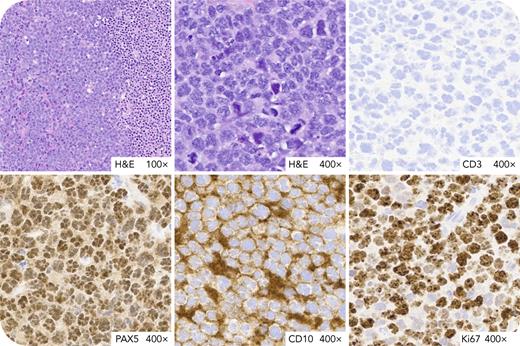A 72-year-old man with idiopathic orbital inflammatory syndrome of the right eye presented with double vision, proptosis, and altered facial sensation. Imaging showed a 5.2 cm mass localized to the right maxillary sinus with extension through the orbital floor into the right zygomatic arch. Histologic sections showed a starry-sky appearance with frequent tingible body macrophages, numerous mitoses, and focal necrosis. The atypical lymphoid cells were intermediate to large with strikingly flowerlike nuclei and fine chromatin. The neoplastic cells were positive for PAX5, CD10, BCL2, BCL6, MUM1, C-MYC, and Ki67 (90%) and negative for CD3, CD5, CD30, Cyclin D1, and terminal deoxynucleotidyltransferase by immunohistochemistry and Epstein Barr virus (EBV)/EBV-encoded small RNAs by in-situ hybridization. Flow cytometry detected a CD10+ κ light chain–restricted B-cell population. Fluorescence in situ hybridization was attempted but was unsuccessful, and next-generation sequencing whole transcriptome studies were negative for IGH, MYC, BCL2, or BCL6 fusions.
Flower cell morphology is classically associated with adult T-cell leukemia/lymphoma and has been only sporadically reported in B-cell lymphomas. To our knowledge, this is the first documented high-grade B-cell lymphoma, not otherwise specified, showing flower cell morphology with photomicrographs from a solid-tissue specimen. Prominent nuclear convolutions in this context should prompt a thorough immunophenotyping workup in conjunction with careful cytomorphologic assessment.
For additional images, visit the ASH Image Bank, a reference and teaching tool that is continually updated with new atlas and case study images. For more information, visit https://imagebank.hematology.org.


This feature is available to Subscribers Only
Sign In or Create an Account Close Modal